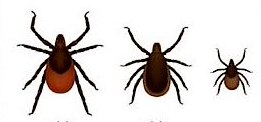Doctors’ Notes
BackLyme Disease
This note is a follow-up to Dr. Godinez’s Doctor’s Note on Ticks…
 In the late Spring and Summer seasons, the potential for Lyme disease is the greatest. The severity of the Winter season may determine how prevalent Lyme disease can be for the upcoming seasons. Understanding what the disease is, as well as its clinical presentations and treatments, will help you alert our office and start care when applicable. (Please see my Doctor’s Note on Ticks for learning about protection against ticks.)
In the late Spring and Summer seasons, the potential for Lyme disease is the greatest. The severity of the Winter season may determine how prevalent Lyme disease can be for the upcoming seasons. Understanding what the disease is, as well as its clinical presentations and treatments, will help you alert our office and start care when applicable. (Please see my Doctor’s Note on Ticks for learning about protection against ticks.)
Lyme disease is a tick borne disease caused by Borrelia burgdorferi. Its vector is Ixodes scapularis, or what is commonly called the deer tick. The deer tick is typically infected with the organism while feeding on white mice. The peak time of the year for Lyme disease is May thru early June (or when the weather is warm), when the nymph stage of the tick is most active and prevalent. The incidence of Lyme disease is highest among children 5-10 years of age.
Lyme disease is typically diagnosed by clinical history and physical examination. It manifests in two stages — early and late. Early infection can be localized or disseminated. The early, localized stage develops 7-14 days after the tick bite. The bite site becomes red and bumpy and progresses to a bull’s eye mark (about 15 cm wide.) The rash can be itchy or mildly tender. Other symptoms include malaise, headache, joint aches, fever, and muscle aches. Most symptoms resolve within 2-4 weeks.
The late stage consists of localized arthritis (usually the knee, and typically males more than females.) The inflammatory conditions can extend into carditis (inflammation of heart), meningitis, peripheral neuritis, and Bell’s palsy. The late stage can take up to 3 months to resolve.
Treatment consists of oral or intravenous antibiotics for 14-21 days. Lyme disease is curable and has an excellent prognosis. Post-exposure preventive medicine is not recommended, because the risk of acquiring Lyme disease after a tick bite is only 1%-2%.
Again, please see my Doctor’s Note on Ticks for techniques to reduce exposure to ticks, and so also to Lyme disease.
Dr. Lucas Godinez, a Kids Plus Doc since 2004, spends a lot of time outdoors, so his expertise on these subjects are both personal and professional.